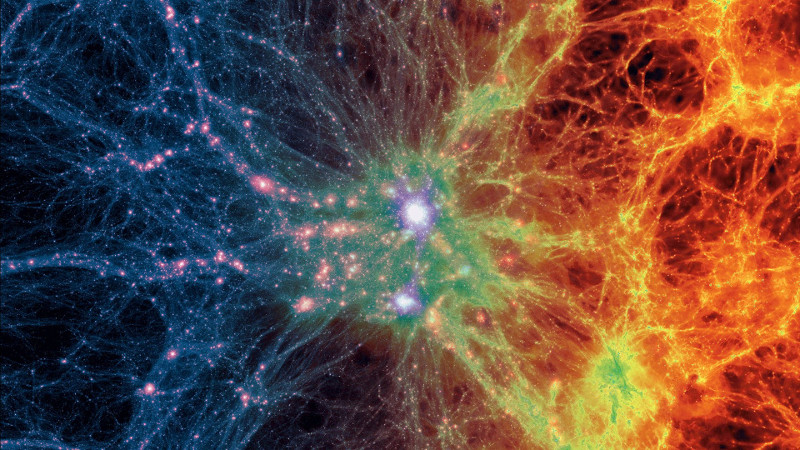Scientists have found the location of the largest beam of radio waves ever discovered in the universe
It is unclear what phenomenon outside the Milky Way emits this powerful beam.
Scientists have discovered the largest fast radio burst (FRB) ever seen and more curious, coming from outside our Milky Way Galaxy.
That signal flew at least a billion light years to reach Earth and it only lasted for a single second. But as long as we can, we have gained a little more understanding of the seemingly endless gap, the space between the two galaxies.
The space is called cosmic web - cosmic web, is a network on which all cosmic matter is distributed in the form of a spider web structure.

"The FRBs are very short, only exist in a millisecond, but they are very powerful radio waves," said Space Physics physicist Ryan Shannon. "Some waves are detected very randomly, and there are no two identical wave outbreaks."
We still know very little about these so-called FRBs : where they come from, what they emanate from the cosmic event, . and why we don't have much information about FRB because so far. , we can't detect many of these events.
This explosion was named FRB 150807 , the number was big but this was the 18th time an FRB was discovered, since the first time we learned of its existence in 2001. There is a fact that the The scientist is not very good at naming.
Although this event seems rare considering the once-a-year rate, many scientists think that FRB appears quite often, just because we can't detect it.
" We estimate that between 2,000 and 10,000 FRB wave outbreaks occur in the sky every day, " said astronomer Vikram Ravi of the research team.
 The place is said to have released FRB 150807.
The place is said to have released FRB 150807.
Normally, FRB is extremely fast, so we have many difficulties in identifying them. Telescopes discover that FRB cannot track the location of these phenomena, when their main task is to observe a large array of universes.
But this time, FRB 150807 is so big that we can find their origin and from there, we will have new clues about how matter from outside the Milky Way "landed" on this Earth.
This FRB boom is the first time we have found detailed information about the space grid
" This is the first time I have discovered an explosion of FRB containing detailed information about the space grid - what is considered a covering on this universe, " said Professor Shannon.
" What's more remarkable is that we can reconstruct its flight path, finding out where this burst of radio waves is coming from, which can be billions of light years away and can contain galaxies. there may be life ".

The wave of FRB 150807.
When the FRBs travel through the universe, they pass through a lot of matter such as gas, ionizing particles and electromagnetic fields . that makes the radio waves distorted.
But in this case, when the Parkes Observatory in Australia discovered FRB 150807, they realized that it was very distorted, which proved that cosmic dust and electromagnetic fields throughout the space grid were not chaotic. like material in this Milky Way.
They also found some places that may have emitted this super-strong burst of waves and in potential galaxies, the VHS7 star system is likely to be the source of FRB 150807.
This galaxy lies about 3.2 to 6.5 billion light-years away, so scientists do not dare to confirm that this time of FRB wave is coming from here. Most likely, a smaller galaxy does not emit enough light to detect.
Anyway, we still get certain information from this finding. Previously, many scientists still suspected that FRB came from phenomena right in this Milky Way, with the discovery of FRB 150807, the suspicion was clarified.
"I think this time, everything has been clearly sorted out," said astronomer James M. Cordes from Cornel University. "Perhaps only one or two of the 18 wave bursts are from our galaxy, the rest may come from other galaxies."
Although we have not yet understood what these FRB beams were born of, at least this discovery gives us a little clearer view of this micro-scale cosmic event.
- Mysterious waves of radio waves outside the universe
- What does the universe look like if you see radio waves?
- Giant telescope captures signals from the universe
- The mysterious radio signal was identified as originating from the universe
- AI detects 72 radio signals from the universe
- Mysterious radio signals from the universe
- For the second time, science has found a source of mysterious radio waves
- Gamma rays are difficult to explain in the universe
- Who invented radio?
- Australia developed artificial intelligence to decipher mysterious sound signals from the universe
- Flash mysterious radio waves from the universe
- The phenomenon of radio waves reverberating mysteriously from the sky has been answered after more than 50 years
 Van Allen's belt and evidence that the Apollo 11 mission to the Moon was myth
Van Allen's belt and evidence that the Apollo 11 mission to the Moon was myth The levels of civilization in the universe (Kardashev scale)
The levels of civilization in the universe (Kardashev scale) Today Mars, the sun and the Earth are aligned
Today Mars, the sun and the Earth are aligned The Amazon owner announced a secret plan to build a space base for thousands of people
The Amazon owner announced a secret plan to build a space base for thousands of people